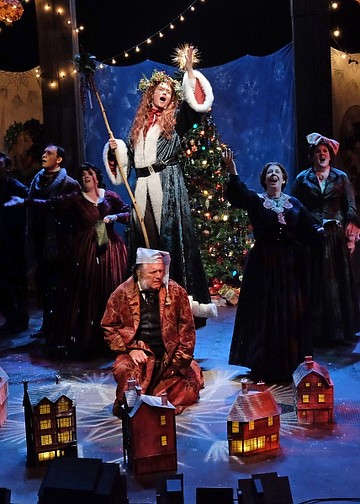 Facebook
Facebook
 X
X
 Instagram
Instagram
 TikTok
TikTok
 Youtube
Youtube

For several years, Cygnet Theatre did a popular version of A Christmas Carol as a live, 1940s radio show — 100 years removed from the original. Sean Murray’s world premiere script returns the durable Dickens story to its roots: a 19th century music hall. It’s a live, pre-radio radio play.
Andrew Hull’s foot-lit proscenium stage has a suggestion of candy canes on the sides. Upstage right, Patrick Marion plays piano in full view of the audience; stage left, a prop table for the sound-makers: from jingling bells to creaking doors to howling London winds. Cast members make no attempt to hide how they manipulate effects. For example, actors use sticks, like puppeteers, to hold up Jacob Marley’s ice-cold chains.

Young children — Tiny Tim among them — are small, fragile puppets. A Dickensian touch: the children’s size and waiflike songs make the adults, bundled in Shirley Pierson’s woolen winter outfits and thick scarves, look like giants.
And, maybe for the first time in all San Diego Christmas Carols, the fat Christmas turkey IS twice the size of Tiny Tim.
Composer Billy Thompson has given familiar music new lyrics. Sir Hubert Parry’s mighty anthem “Jerusalem (And Did Those Feet in Ancient Time)” now promises to bring Scrooge’s soul “into the light.”
R. Craig Wolf’s excellent lighting, shafts and cones of color spearing in from all directions give scenes an otherworldly, mythic element.
Over the years, possibly because it’s so familiar, local versions of Christmas Carol have shrunk the story down to its basic events. Murray’s script fleshes it out. Dialogue taken from the book adds motives, deepens characters, and makes the old feel new.
All are plusses, but the sound mix needs a fix. Too often it’s difficult to make out snatches of dialogue and song lyrics. Some in the cast speak too rapidly; others muffle speeches with over-cooked British accents; and the chorus’ drown out the lead singer.
Tom Stephenson’s Scrooge differs from so many others for what he doesn’t do. He isn’t a cartoon with comic/meanie emotions, or a pushover grump certain to change his ways. Except for exaggerated noises — as when Scrooge slurps gruel like an antique vacuum cleaner — Stephenson makes him an actual person, a bitter old man imprisoned by materialism. He goes through a genuine Dark Night of the Soul and may, or may not, see the light. When Scrooge does, Stephenson earns it, and goes rightfully nuts.
A full-scale Christmas Carol would require at least a cast of 30. At Cygnet, seven performers sing, dance, play multiple characters (with multiple costume changes), truck props on and off the stage, do the sound effects – oh, and sing carols and entertain beforehand. Maggie Carney, Charles Evans, Melissa Fernandes, Melinda Gilb, David McBean (a truly eerie Jacob Marley), and Patrick McBride handle their many duties to good effect — and should ask for overtime remuneration.


For several years, Cygnet Theatre did a popular version of A Christmas Carol as a live, 1940s radio show — 100 years removed from the original. Sean Murray’s world premiere script returns the durable Dickens story to its roots: a 19th century music hall. It’s a live, pre-radio radio play.
Andrew Hull’s foot-lit proscenium stage has a suggestion of candy canes on the sides. Upstage right, Patrick Marion plays piano in full view of the audience; stage left, a prop table for the sound-makers: from jingling bells to creaking doors to howling London winds. Cast members make no attempt to hide how they manipulate effects. For example, actors use sticks, like puppeteers, to hold up Jacob Marley’s ice-cold chains.

Young children — Tiny Tim among them — are small, fragile puppets. A Dickensian touch: the children’s size and waiflike songs make the adults, bundled in Shirley Pierson’s woolen winter outfits and thick scarves, look like giants.
And, maybe for the first time in all San Diego Christmas Carols, the fat Christmas turkey IS twice the size of Tiny Tim.
Composer Billy Thompson has given familiar music new lyrics. Sir Hubert Parry’s mighty anthem “Jerusalem (And Did Those Feet in Ancient Time)” now promises to bring Scrooge’s soul “into the light.”
R. Craig Wolf’s excellent lighting, shafts and cones of color spearing in from all directions give scenes an otherworldly, mythic element.
Over the years, possibly because it’s so familiar, local versions of Christmas Carol have shrunk the story down to its basic events. Murray’s script fleshes it out. Dialogue taken from the book adds motives, deepens characters, and makes the old feel new.
All are plusses, but the sound mix needs a fix. Too often it’s difficult to make out snatches of dialogue and song lyrics. Some in the cast speak too rapidly; others muffle speeches with over-cooked British accents; and the chorus’ drown out the lead singer.
Tom Stephenson’s Scrooge differs from so many others for what he doesn’t do. He isn’t a cartoon with comic/meanie emotions, or a pushover grump certain to change his ways. Except for exaggerated noises — as when Scrooge slurps gruel like an antique vacuum cleaner — Stephenson makes him an actual person, a bitter old man imprisoned by materialism. He goes through a genuine Dark Night of the Soul and may, or may not, see the light. When Scrooge does, Stephenson earns it, and goes rightfully nuts.
A full-scale Christmas Carol would require at least a cast of 30. At Cygnet, seven performers sing, dance, play multiple characters (with multiple costume changes), truck props on and off the stage, do the sound effects – oh, and sing carols and entertain beforehand. Maggie Carney, Charles Evans, Melissa Fernandes, Melinda Gilb, David McBean (a truly eerie Jacob Marley), and Patrick McBride handle their many duties to good effect — and should ask for overtime remuneration.
Comments